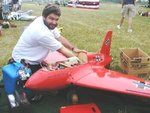cheddar cheese
Major General
Why did it use a skid? And not landing gear?
I think it was to save weight and materials. The updated Me-263/Ju-248 featured retractable tricycle landing gear.
More info on this site: www.walter-rockets.i12.com/walter/me263.htm




